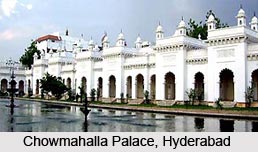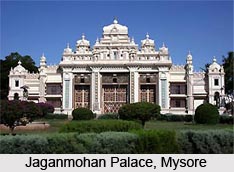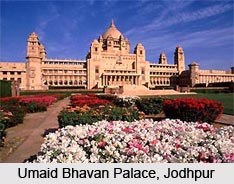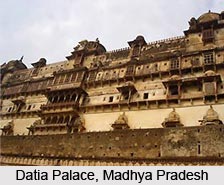Palaces of India are innumerable, scattered throughout the length and breadth of the country and belonging to numerous kings and rulers who ruled India for many centuries. The royal residences of these kings, the palaces are excellent works of architecture, which speak of the creative abilities, and artistic sensibilities of these rulers. These palaces are the assets of India and enhance the tourist quotient of the state where they are located. Some of these palaces have now been converted in to luxurious hotels and also open for public viewing. The palaces are maintained by the government as they bear ample testimony to the rich cultural Indian heritage.
Amar Mahal Palace
The Amar Mahal Palace is a grand palace in Jammu and Kashmir, which was built by Raja Amar Singh and presently has been transformed into a museum. This palace contains several interesting exhibits which consists of a golden throne that weighs 120 kg, some Kangra paintings, Pahari miniature paintings, a library which houses 25,000 unique books and many other art beautiful collections.
Bangalore Palace
The Bangalore Palace resembles the Windsor Castle in England and is located in Bangalore and is a well-known venue for international music bands, rock stars. Bella Vista in Hyderabad was inspired from the Heney-on-Thames of England and was a royal palace of the Nizam.
 Chowmahalla Palace
Chowmahalla Palace
Chowmahalla Palace was the official residence of Nizams of Hyderabad and the seat of Asaf Jahi dynasty. In the Persian language, `Chahar` implies four while in Arabic language, `Mahalat` (plural of Mahal) stands for palaces and therefore this gave birth to the term `Chowmahallat` or four palaces. This palace received the UNESCO Asia Pacific merit award for its preservation of rare cultural heritage.
Falaknuma Palace
The Falaknuma Palace was built by the Paigah, Nawab Vikar-ul-Umra in the southern part of the old city of Hyderabad. This palace is considered to be one of the most magnificent palaces in the state of Andhra Pradesh. Paigarh Hyderabad State owned this palace, but it was later confiscated by the Nizams of Hyderabad. It is located in Faluknama which is at a distance of 5 km from Charminar and was constructed by Nawab Vikar-ul-Umra, the then minister of Hyderabad.
Hill Fort Palace
Hill Fort Palace was a palace of the Nizams of the state of Hyderabad where Prince Moazzam Jah stayed. The Nawabs of Hyderabad were known to reside in this grand palace which is situated near Naubat Pahad. Historians claim that this palace was the official residence of Prince Moazzam Jah who was the younger son of the last Nizam of Hyderabad. Today, this palace has been converted into Ritz Hotel.
 Jaganmohan Palace
Jaganmohan Palace
Jaganmohan Palace located in Mysore, which was the residence of Wodeyars, kings of Mysore. This was initially utilized by the Wodeyar Kings of Mysore. Presently, this palace functions as an art gallery and a hall where public functions are held. The construction of Jaganmohan Palace was finished in the year 1861.
Kangla Palace
Kangla Palace is located in Kangla in Manipur where the Metei rulers of Manipur resided. Initially, this palace was located on both the banks of River Imphal but today it is present just on the western end of the river bank of Imphal. The word `Kangla` means dry land in the Meetei dialect and this palace was the dwelling of the Metei kings of the state of Manipur.
Kilimanoor Palace
Kilimanoor Palace is the birthplace of Raja Ravi Varma, the eminent painter of India.
Kuthira Malika
Kuthira Malika is located in Thiruvananthapuram, the capital of Kerela and was built by Swathi Tirunal Rama Varma. It is situated on the south-eastern side of Padmanabhaswamy Temple in Thiruvananthapuram.
Laxmipuram Palace
Laxmipuram Palace was the residence of the royal family of Koi thampurans and is located in Kottayam district of Kerela. This palace is located in Changanacherry Taluk in the district of Kottayam in Kerala. The royal kings of the dynasty of Koi thampurans resided here. Distinguished Malayalam singer L.P.R. Varma is also believed to belong to this palace.
Leh Palace
Leh Palace was constructed by King Sengee Namgyal on the lines of the Potala Palace in Lhasa. This grand place was built by King Sengge Namgyal in the 17th century. However, it was later deserted when Dogra forces claimed administration of the area of Ladakh. This palace contains nine stories. The Archaeological Survey of India is supervising the restoration of this palace.
Maharaja Palace
The Maharaja Palace in Vadodara, Gujarat is a series of palaces here the Gaekwad family resided.
Mahboob Mansion
Mahboob Mansion was built in the late nineteenth century, where the sixth Nizam, Mahbub Ali Khan, Asaf Jha VI resided occasionally.
Marble Palace
The Marble Palace in North Kolkata was constructed by Raja Rajendra Mullick in 1835. It is located at Muktaram Babu Street and is said to be the most elegant buildings of Kolkata, belonging to the 19th century. This palace is known for its spectacular marble floors and walls.
Matancherry Palace
The Matancherry Palace is also referred to as the Dutch Palace and is located in Kochi in Kerela. It boasts of beautiful Kerala mural paintings which portray the art reflected in Hindu temples, portraits and exhibits of the Kings of Kochi.
Mysore Palace
The Mysore Palace was the official residence of the royal family of Mysore, and the architecture was an aesthetic blend of Hindu, Muslim, Rajput and Gothic styles of architecture. The Wodeyar kings resided in the Mysore Palace. This palace is one of the most significant tourist destinations in the country.
Nedumpuram Palace
The Nedumpuram Palace is located in Thiruvalla in Kerela and belonged to the rulers of the Kulasekhara dynasty. The kings belonging to the Kulashekhara dynasty are believed to have stayed in this palace. However, during the campaign of Tipu Sultan, the family of the Kulashekhara dynasty left the palace and retreated to Travancore.
Neermahal
The royal palace of Neermahal was built by Bir Bikram Kishore Debbarman and is located in Agartala, the capital of Tripura. It is situated in the middle of the Rudrasagar Lake and is a unique blend of Hindu and Muslim architectural style.
Padmanabhapuram Palace
Padmanabhapuram Palace is located near Thiruvananthapuram at the foothills of the Veli Hills.
Purani Haveli
Purani Haveli was the official residence of the Nizamand is also referred to as Haveli Khadeem.
Rajendra Vilas
The Rajendra Vilas is located on top of the Chamundi Hills in Mysore, Karnataka. It is placed at a height of 1,000 feet and is believed to gave been used by the Wodeyar kings of Mysore. The construction of the palace of Rajendra Vilas was finished in 1938-1939.
Shakthan Thampuran Palace
The Shakthan Thampuran Palace is located in Thrissur of Kerela, and was reconstructed in Kerela-Dutchstyle in 1795. The Shaniwar Wada is a palace located in the center of the Pune city and is the official residence of the Peshwas.
Thirumalai Nayakkar Mahal
The Thirumalai Nayakkar Mahal was built in the 17th century by King Thirumalai Nayak.
Ujjayanta Palace
The Ujjayanta Palace is a former royal palace, which is situated in Agartala in Tripura. The Tripura Tourism Department arranges tours and millions of tourists visit the Ujjayanta Palace every year. Historians claim that the name `Ujjayanta Palace` was given by nobel laureate Rabindranath Tagore.
 Umaid Bhawan Palace
Umaid Bhawan Palace
The Umaid Bhawan Palace in Jodhpur, Rajasthan, and is last among the magnificent palaces constructed in India. A portion of this palace is taken care of by Taj Hotels. The palace was named after Maharaja Umaid Singh, who was the grandfather of the current owners of the palace. It consists of 347 rooms and is now the official residence of the royal family of Jodhpur.
Datia Palace
The Datia Palace is located in the state of Madhya Pradesh, about 75 km from the city of Gwalior. There are seven floors of this palace and this characteristic imparts a unique appeal to this palace. This building is also referred to as the `Satkhanda Palace` or `Purana Mahal` palace. The palace is located on the western part of Datia and portrays an excellent fusion of Rajput architecture and Mughal architecture.
 Aga Khan Palace
Aga Khan Palace
The Aga Khan Palace was created in the year 1892, by Sultan Muhammed Shah Aga Khan III in the area of Pune, Maharashtra. This majestic palace was constructed by the Sultan to extend his cooperation and support towards the impoverished who resided in the neighbouring regions of Pune and were affected by a famine.
Jahangiri Mahal
This Indian palace is considered to be the most interesting building present in the Agra Fort. Jahangiri Mahal was known to be the main `zenana` which housed the royal women of the palace, particularly the Rajput wives of the Mughal Emperor Akbar. Later, Nur Jahan, the wife of Mughal emperor Jahangir also utilized this Mahal as her personal palace. The architecture of Jahangiri Mahal is a reflection of a blend of Central Asian style and Hindu style of architecture. It was built by Akbar for his beloved son Jahangir, his successor to the throne of India.
The land of India has witnessed the regime of innumerable kings, Nawabs and rulers since ancient ages and thus possesses a vast quantity of several marvellous palaces scattered in its various states. Madhya Pradesh, West Bengal, Jammu and Kashmir, Maharashtra, Andhra Pradesh, Karnataka, Bihar, Manipur and many other Indian states boast of various kinds of palaces, which are thronged by millions of national as well as foreign tourists every year. Other important palaces which are worth mentioning are Pataudi Palace, Mayurbhanj Palace, Moti Bagh Palace, Nahar Singh Mahal Palace and numerous others.



















